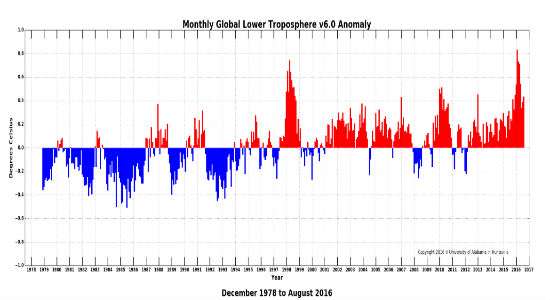August and Year-to-Date Are Second Hottest in Satellite Record: Global Temperature Trend Update
Global climate trend since Nov. 16, 1978: +0.12 C per decade
Through the first eight months of the year, 2016 seems to be racing toward what might be its place in history — as the second warmest year in the satellite temperature record. But just by a little bit, according to Dr. John Christy, director of the Earth System Science Center at the University of Alabama in Huntsville in a press release. "While global average temperatures peaked higher this year than they did in 1998, temperatures fell faster this spring and summer to levels that are cooler than they were at this same time of year in 1998. We had three months this year that were warmer than their 1998 counterparts, and five that were cooler. There is really no reliable way of predicting what the next four months will do, compared to those same months in 1998."
With temperatures that were 0.55 C (about 0.99° F) warmer than seasonal norms, August 2016 was the warmest August in the Northern Hemisphere in the satellite temperature record. August 1998 was second warmest at 0.49 C warmer than normal. August 2016 was the second warmest August in the tropics, trailing August 2015 0.52 to 0.50 C. It was the third warmest in the Southern Hemisphere, where the August 2016 average was 0.32 C warmer than normal. August 1998's Southern Hemisphere average was hottest at 0.54 C warmer than seasonal norms.
Global climate trend since Nov. 16, 1978: +0.12 C per decade
August temperatures (preliminary)
Global composite temp.: +0.44 C (about 0.79 degrees Fahrenheit) above 30-year average for August.Northern Hemisphere: +0.55 C (about 0.99 degrees Fahrenheit) above 30-year average for August.
Southern Hemisphere: +0.32 C (about 0.58 degrees Fahrenheit) above 30-year average for August.
Tropics: +0.59 C (about 0.90 degrees Fahrenheit) above 30-year average for August.

According to the latest (July) National Oceanic and Atmospheric Administration data global temperature was the hottest ever since the late 19th century:
For the 15th consecutive month, the global land and ocean temperature departure from average was the highest since global temperature records began in 1880. This marks the longest such streak in NOAA's 137 years of record keeping. The July 2016 combined average temperature over global land and ocean surfaces was 0.87°C (1.57°F) above the 20th century average, besting the previous July record set in 2015 by 0.06°C (0.11°F). July 2016 marks the 40th consecutive July with temperatures at least nominally above the 20th century average. The last time July global land and ocean temperatures were below average was in 1976 (-0.09°C / -0.16°F). Although continuing a record streak, July 2016 was also the lowest monthly temperature departure from average since August 2015 and tied with August 2015 as the 15th highest monthly temperature departure among all months (1,639) on record. However, since July is climatologically the globe's warmest month of the year, the July 2016 global land and ocean temperature (16.67°C / 62.01°F) was the highest temperature for any month on record, surpassing the previous record set in July 2015. July 2016 was the 379th consecutive month with temperatures at least nominally above the 20th century average. The last month with temperatures below the 20th century average was December 1984 (-0.09°C / -0.16°F).
Go here for UAH's monthly temperature data.


Show Comments (139)